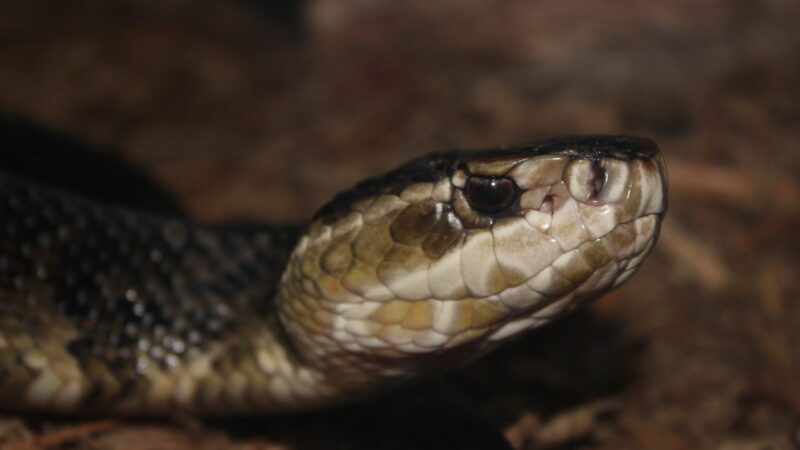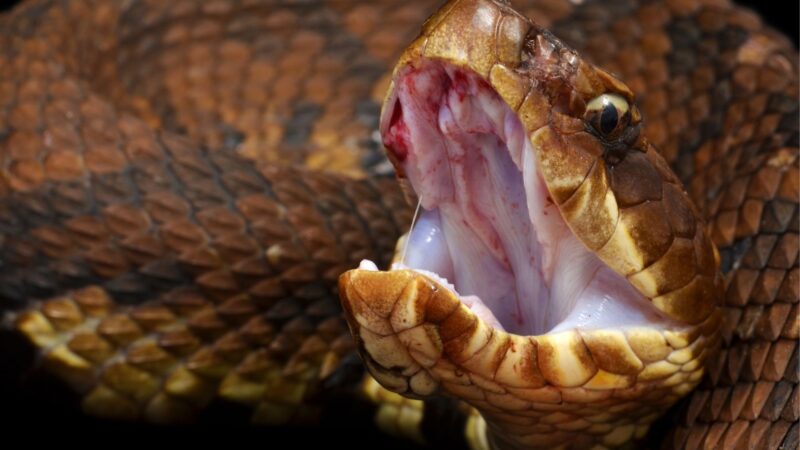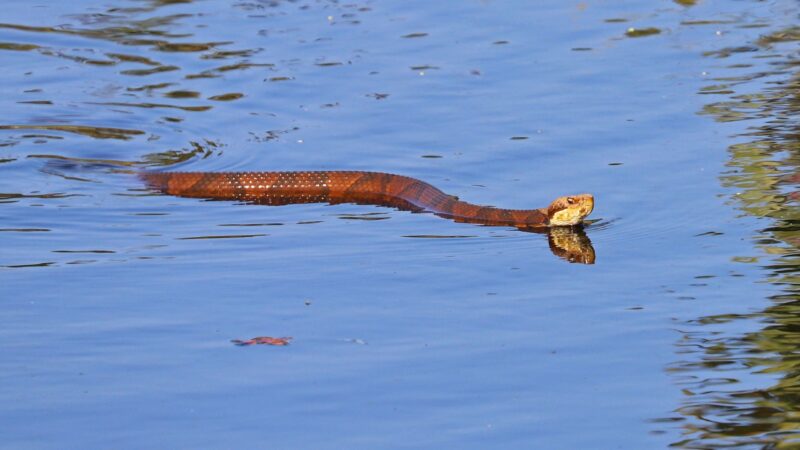Unless they’re being kept as pets, a Cottonmouth snake on your property is an immediate cause for concern. Although they are less likely to attack, they are still venomous snakes capable of biting when feeling threatened.
So, how to get rid of Cottonmouth snakes? The only way is to contact a local wildlife professional or expert snake handler to safely remove and relocate the snake. Afterward, snake-proof your area to prevent them from coming back.
To know more about this species, this comprehensive guide will provide you with all the information you need!
What Are Cottonmouth Snakes?

Known as large, venomous semi-aquatic pit vipers, Cottonmouth snakes (Agkistrodon piscivorus and Agkistrodon conanti) are most often difficult to identify for non-experts. This is due to their varying coloration and pattern.
Some Cottonmouths have a dull yellow and brown base color with dark bands across its keeled scales while others may be a solid brown or black color.
Like other venomous snakes, they are characterized by the presence of pits on each side of their triangular heads and have elliptical-shaped pupils. They also have thick snouts and narrow necks.
What Do Cottonmouth Snakes Like?
Considered habitat generalists, Cottonmouths thrive in almost any aquatic environment. This ranges from high-elevation streams to depressional wetlands and up to river floodplains.
Although they prefer wetlands, they may also be found on land. They tend to bask on branches, rocks, and logs but rarely climb trees.
What Do Cottonmouth Snakes Eat?
Cottonmouths are predators of terrestrial vertebrates and fish. They catch their food either by striking or suffocating them and then injecting their venom. They are able to detach their jaw bones to open their mouths wider to accommodate bigger prey.
Some common species they consume are catfish, southern leopard frogs, young black rat snakes, and least shrews.
Where Do Cottonmouth Snakes Live?
They are primarily found in wetlands across southeastern states. Alabama is home to both known species of cottonmouths—the Northern Cottonmouth (Agkistrodon piscivorus) and the Florida Cottonmouth (Agkistrodon conanti).
How Long Do Cottonmouth Snakes Live?
There is little information regarding the lifespan of Cottonmouth snakes after this writing. It is assumed that they live less than 10 years in the wild. In captivity, the oldest recorded Cottonmouth lived up to 24 and a half years old.
How Big Will a Cottonmouth Snake Get?
Cottonmouths are usually 2 to 4 feet long at maturity, but they are able to reach up to 6 feet in length. Interestingly, newborn snakes can reach nearly a foot in size.
What Is the Behavior of Cottonmouth Snakes?
Cottonmouth snakes are solitary and sedentary, which means they do not interact with other species and do not wander far from their habitats. Although they are primarily nocturnal, they can still be seen during the day.
They are ambush predators but are also active foragers of prey. They are quite aggressive, especially when provoked or disturbed.
Are Water Moccasins and Cottonmouths the Same Snake?
Yes, they both refer to the same snake. Water moccasin is derived from their preference for living in aquatic habitats while Cottonmouth refers to the snake’s white upper lip that’s visible when it opens its mouth as a defense mechanism.
Cottonmouth snakes actually have nearly 60 nicknames, including gaper, mangrove rattler, and water mamba. They are also commonly mistaken for other nonvenomous aquatic snakes.
Related: How to Get Rid of Rattlesnakes | Effective and Safe Methods
What Is The Largest Cottonmouth Snake Ever Recorded?

According to the Virginia Herpetological Society, it was a Cottonmouth found in the Dismal Swamp area. It measured a whopping 6.2 feet—an impressive feat considering the fact adult snakes are 2 to 4 feet on average.
Which Is Worse: Cottonmouth or Copperhead?
Although Cottonmouth snake venom is generally considered more toxic, Copperheads still cause the majority of the reported snake bites in the US.
In fact, Copperheads accounted for 65% of cases in 2014 alone while Cottonmouths only accounted for 3%. However, both snake species are docile and only resort to biting when provoked or disturbed.
Are Cottonmouth Snakes Poisonous?
No, they are venomous. Cottonmouth snakes have cytotoxic venom which is less fatal compared to other types of venoms. However, it still causes tissue destruction which may lead to loss of limb function.
Related: Black Snakes | Are They Poisonous?
Are Cottonmouth Snakes Aggressive?

No, they prefer avoiding direct contact with both humans and other animals. Most Cottonmouth snake bite incidents are caused by people intentionally provoking them or accidentally stepping on them.
Can a Cottonmouth Snake Kill You?
Deaths from Cottonmouth snake bites are extremely rare as bites don’t usually require antivenom. However, immediate medical care from physicians is still necessary to treat the affected area.
Can You Remove Cottonmouths Yourself?
It’s possible but we strongly advise against it because they are venomous snakes. Never attempt to handle Cottonmouths, not even a dead one.
How to Get Rid of Cottonmouth Snakes?
In the rare event that you encounter Cottonmouth snakes near your property, don’t engage with them. Immediately call local wildlife professionals or an expert snake handler to remove them.
Again, it is worth reiterating to never attempt to handle these venomous snakes.
Related: Best Natural Snake Repellents: A Complete Guide
How to Keep Cottonmouths From Coming Back?

To prevent Cottonmouth snakes from returning, follow these strategies:
- All possible entry points in your house should be eliminated by sealing. Doors should be amended with sweeps and galvanized screens should be attached to vents and windows.
- Establish fences around the property, especially if you have children or pets that constantly play outside. The fence should be 3 feet wide and buried 3 to 6 inches into the ground at a 30° angle.
- If you have gates, amend them with heavy weights or strong springs to keep them from opening by themselves.
- Keep vegetation under control by trimming, pruning, or applying herbicides when necessary.
- Remove food supply by reducing rodent populations. Avoid using poison as this may affect pets. Make sure food and grain is always properly stored.
- Eliminate debris found around foundations or under porches to reduce possible hiding spots for the snakes.
List of Sources
Brock, E. M., & Howard, W. E. (1962). Control methods for snakes.
Cox, R. D., Parker, C. S., Cox, E. C. E., Marlin, M. B., & Galli, R. L. (2018). Misidentification of copperhead and cottonmouth snakes following snakebites.
Department of Forestry and Natural Resources. (n.d.). Western Cottonmouth (Agkistrodon piscivorus).
Good, G. (n.d.). Agkistrodon piscivorus conanti.
Route, L., & Sawarkar, A. (2023). Snake bite – cytotoxic effects of snake venom: a rare clinical image.
- How to Get Rid of Copperheads | Practical Guide - August 27, 2023
- How to Get Rid of Corn Snakes | What Makes Them Aggressive? - August 27, 2023
- How to Get Rid of Alligators | Safety Measures and Removal Methods - July 16, 2023
